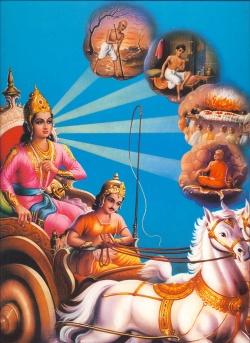Mātali
The name given to the chariot driver (sahgāhaka) of Sakka. The Mātali of the present age had a son, Sikhandhi, with whom Bhaddā Suriyavaccasā, daughter of Timbarū, was in love; but later she transferred her affections to Pañcasikha (D.ii.268). Mātali is Sakka's constant companion and accompanies him everywhere, more as a confidant than as a servant. See, e.g., the conversation reported at S.i.221, 224, 234ff.; and Vv.iv. 9.
Thus, he was by Sakka's side in the war against the Asuras and drove his chariot when he fled with his bride Sujātā. The chariot is called Vejayanta ratha and is drawn by one thousand Sindh horses (DhA.i.279f.; J.i.202f). Mātali often accompanied Sakka on his journeys to the world of men, changing his form e.g., to that of a fish in the Culladhanuggaha Jātaka, a brahmin in the Bilārakosiya Jātaka and in the Suddhābhojana Jātaka, and a big black dog in the Mahākanha Jātaka. On several occasions he was sent by Sakka to fetch human beings to Tāvatimsa - e.g., Guttila, Nimi, Makhādeva and Sādhīna - and he proved an excellent guide, pointing out to the visitors the places of interest passed on the way.
When the Buddha descended from Tāvatimsa, after preaching there the Abhidhamma, he was accompanied, on the left, by Mātali, offering celestial scents, garlands and flowers (DhA.iii.226). Both in the Bilārakosiya and the Sudhābhojana Jātakas Mātali is spoken of as the son of Suriya.
Ananda is said to have been Mātali during several lives (J.i.206; iv.180; v. 412; vi.129); so also Mahā Kassapa (J.iv.69).
In the Mahāsamaya Sutta (D.ii.258), Mātali is described as a Gandhabba chief, while in the ātānātiya Sutta (D.iii.204) he is mentioned among the chief Yakkhas to be invoked by followers of the Buddha in time of need.
